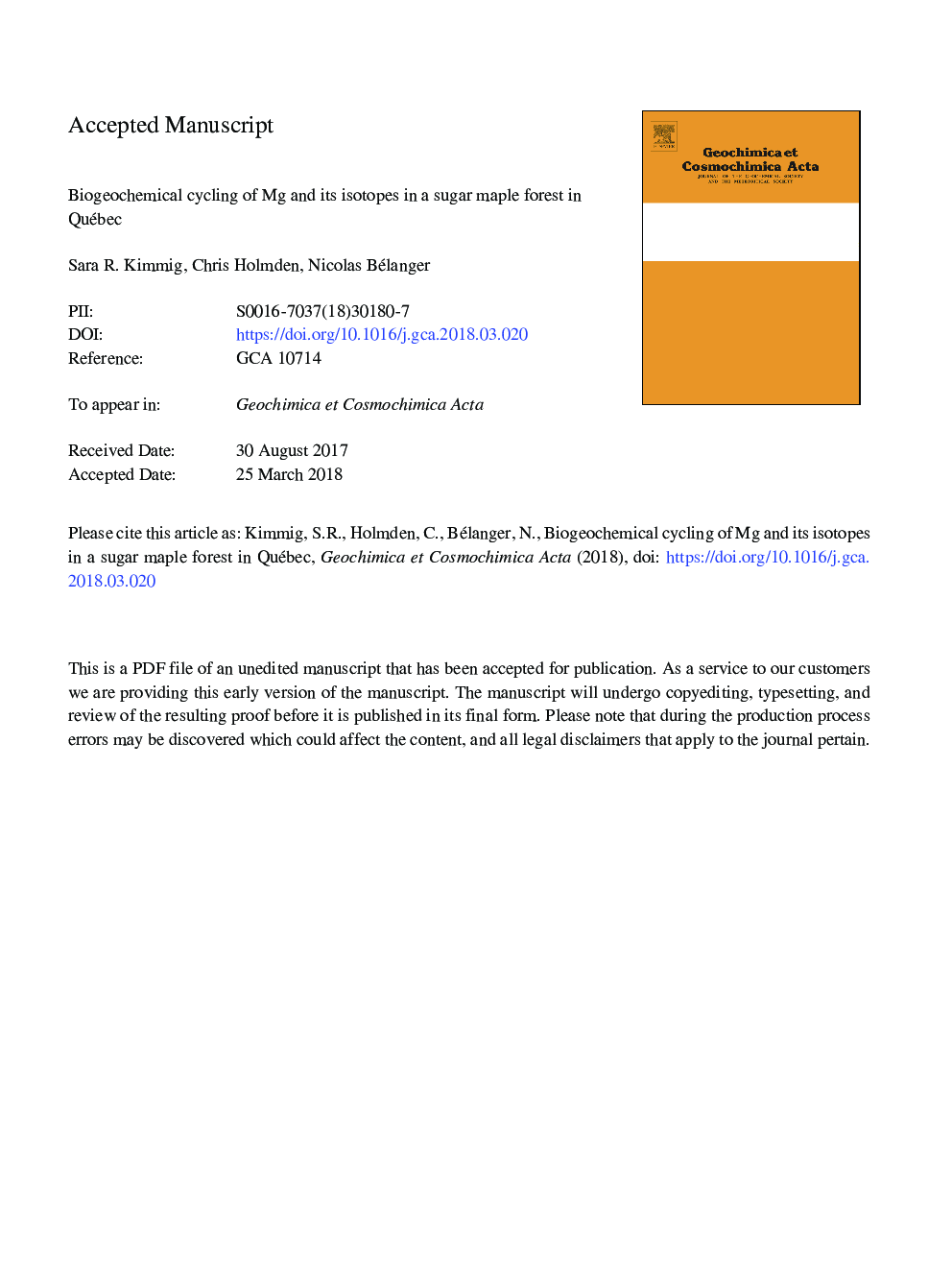| کد مقاله | کد نشریه | سال انتشار | مقاله انگلیسی | نسخه تمام متن |
|---|---|---|---|---|
| 8910758 | 1637927 | 2018 | 57 صفحه PDF | دانلود رایگان |
عنوان انگلیسی مقاله ISI
Biogeochemical cycling of Mg and its isotopes in a sugar maple forest in Québec
دانلود مقاله + سفارش ترجمه
دانلود مقاله ISI انگلیسی
رایگان برای ایرانیان
کلمات کلیدی
موضوعات مرتبط
مهندسی و علوم پایه
علوم زمین و سیارات
ژئوشیمی و پترولوژی
پیش نمایش صفحه اول مقاله

چکیده انگلیسی
A Mg isotope study of sugar maple (Acer saccharum Marsh.) in a field site in southern Québec, Canada, and seedlings grown in sterile soil substrate in the laboratory, both demonstrate per mil level within-tree Mg isotope fractionation. However, only sugar maple seedlings grown in the laboratory fractionate Mg isotopes during uptake into fine roots, favoring heavy isotope enrichment in the plant compared to the growth medium. Absence of uptake-related Mg isotope fractionation in field stands of sugar maple is tentatively attributed to the activities of the arbuscular mycorrhizal fungi that colonize fine roots of the trees in the field, but were absent from the laboratory grown specimens. The fungi facilitate nutrient uptake for the tree, while the tree provides valuable carbohydrates to the fungi. Without the symbiotic fungi, pot-grown trees in the laboratory are visibly stressed and often die. The mechanisms responsible for Mg isotopic fractionation in stressed trees remain to be elucidated. Rivers are isotopically light compared to bedrock weathering sources of Mg, and this has bearing on the δ26Mg value of the continental weathering flux of Mg to the oceans, which is an important parameter in studies of ocean Mg cycling in the geological past. If uptake-related fractionation is negligible in many other naturally growing tree species, as it is in sugar maple, then forest growth will exert little or no influence on the δ26Mg value of the export flux of Mg to first-order streams and rivers, and in turn the ocean Mg cycle. Above the tree line, preferential retention of heavy Mg isotopes in clay minerals formed during silicate weathering has been linked to the low δ26Mg values in rivers. In the forested catchment of this study there is no clear evidence for these effects. The 1â¯N HNO3 leach of the Bf-BC and C mineral soils, which are often used to identify minerals that may be releasing Mg and other base cations to plant-available pools, have the same average δ26Mg value (â0.66â°, nâ¯=â¯2) as the litter layer and exchangeable leach of the forest floor, all soil solutions, and the stream (â0.63â¯Â±â¯0.17â° 2Ï, nâ¯=â¯23). More revealing is the molar Mg/Ca ratio of the 1â¯N HNO3 treatment (0.17), which is nearly identical to the bulk Mg/Ca ratio of the aboveground biomass (0.14). We conclude that the 1â¯N HNO3 leach in this setting releases Mg from secondary minerals, such as vermiculite, other clays, and amorphous phases, which have taken up plant-recycled Mg and Ca that has filtered down through the soil from the litter layer of the forest floor. A single mineral, chlorite, with an estimated δ26Mg value of â0.78â°, appears to be responsible for supplying most of the Mg that is circulating between the forest and soils in this setting, which is weathered and cached over timescales of thousands of years.
ناشر
Database: Elsevier - ScienceDirect (ساینس دایرکت)
Journal: Geochimica et Cosmochimica Acta - Volume 230, 1 June 2018, Pages 60-82
Journal: Geochimica et Cosmochimica Acta - Volume 230, 1 June 2018, Pages 60-82
نویسندگان
Sara R. Kimmig, Chris Holmden, Nicolas Bélanger,